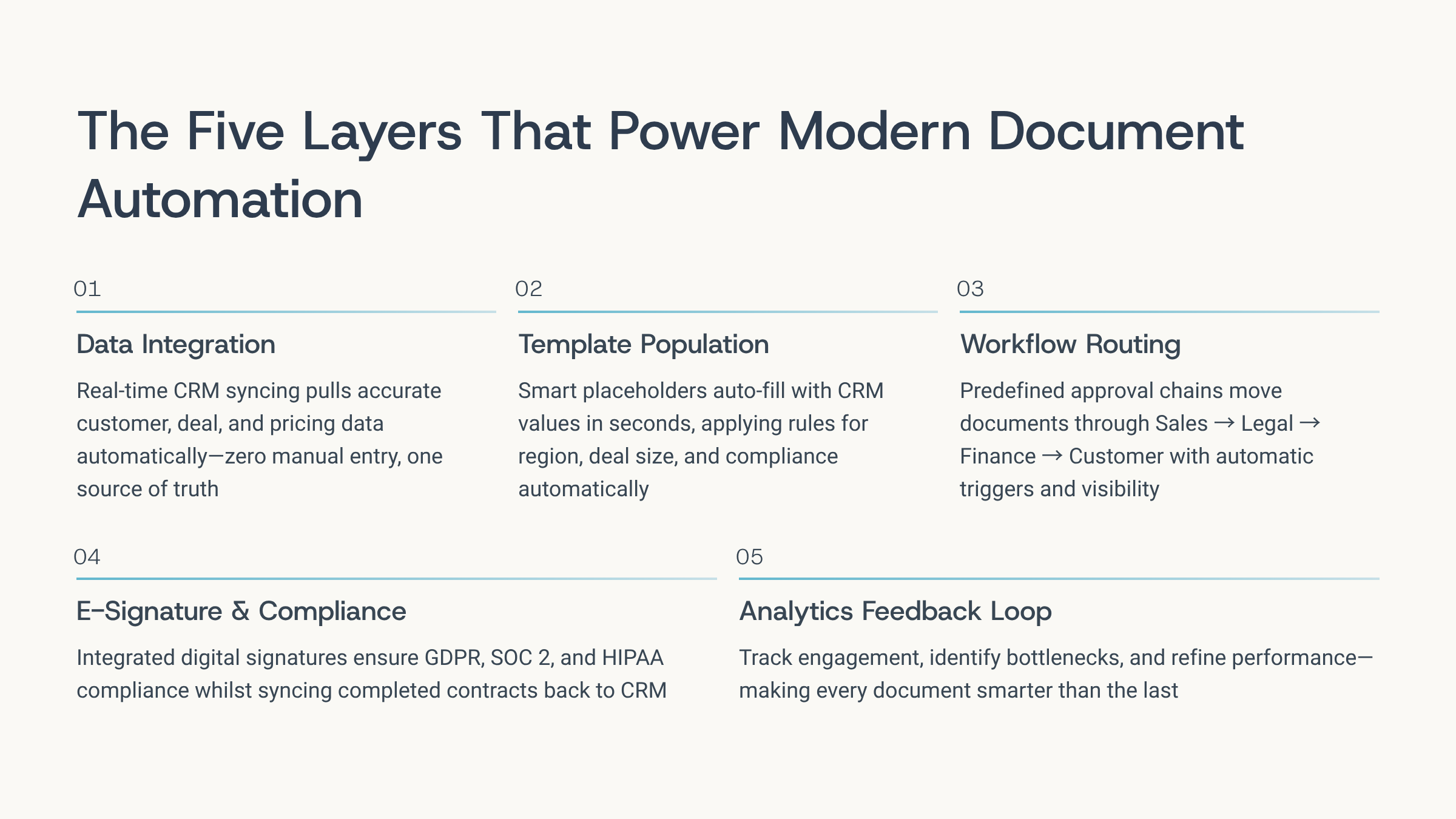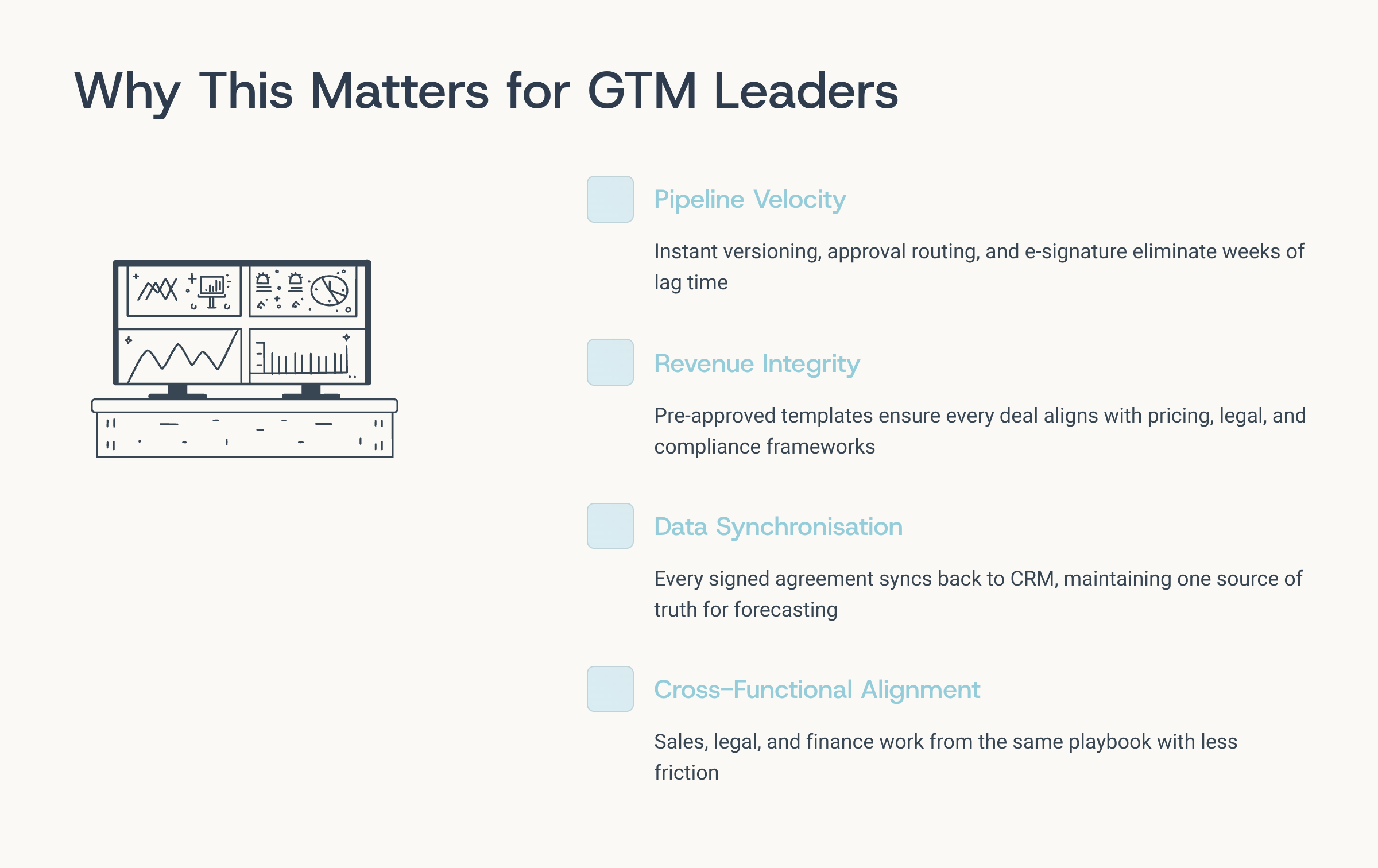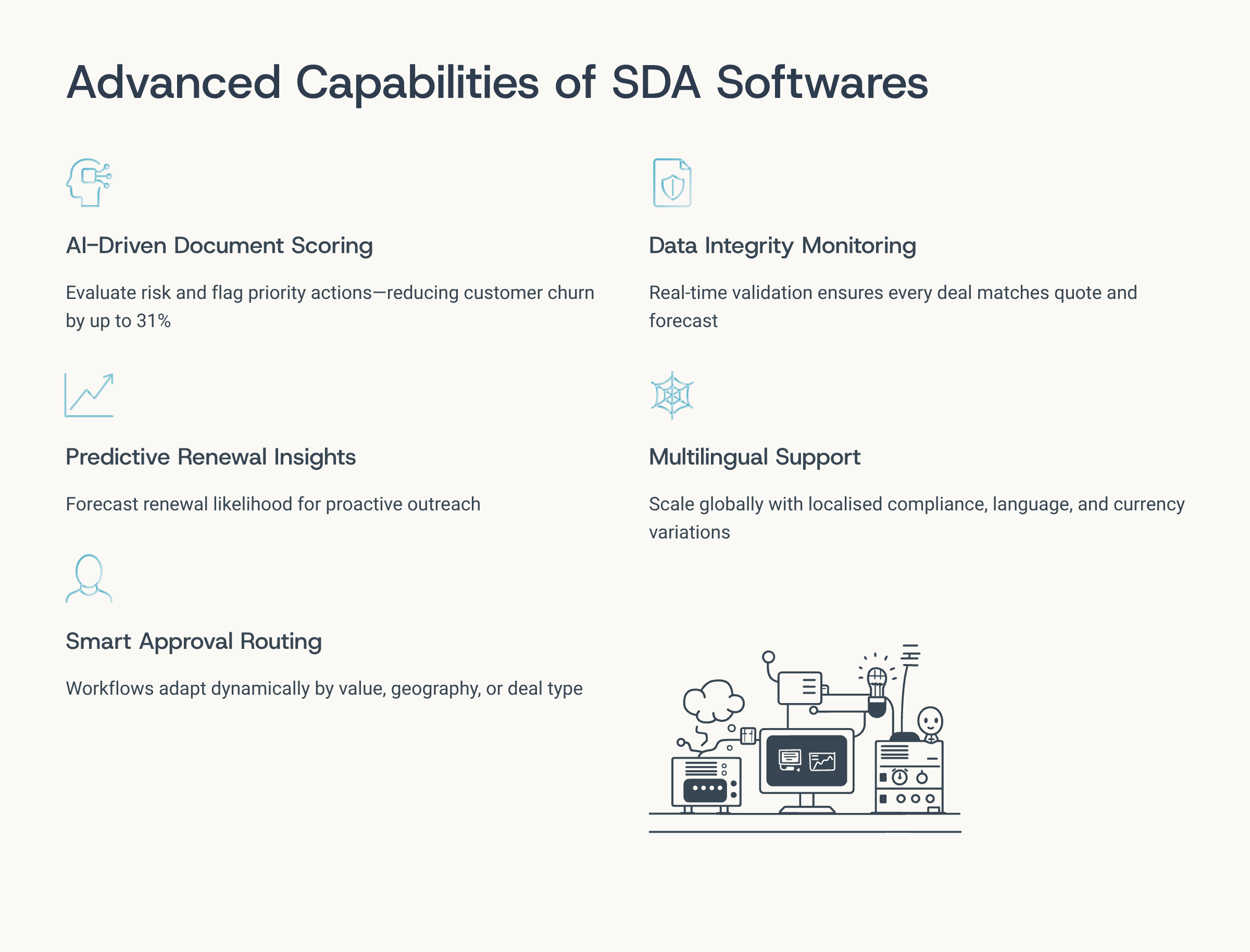Sales Document Automation: A Complete GTM Leader’s Guide
Article written by
Kate Williams

INSIDE THE ARTICLE
SHARE THIS ARTICLE
Summary
Sales document automation represents a critical evolution in go-to-market operations, addressing the challenge of manual document creation and management that costs sales teams 20-30% of their productive selling time. This guide explores how organizations can evaluate and implement document automation solutions to accelerate deal cycles, ensure consistency, and enable revenue teams to focus on relationship building rather than administrative tasks.
I’ve always believed in the motto, “Something new, every day.”
And honestly, the first time I heard that sales reps spend nearly 70% of their time on documentation instead of selling, I remember saying out loud — “Wait, what?!”
Because I’ve seen it up close. During one of my earlier projects, I sat in on a sales sprint review where a rep said, “I spend more time fixing proposal formats than actually pitching.” Everyone laughed — but it was the kind of laughter that hides frustration.
That’s when I realized: this isn’t a small workflow issue. It’s a systemic sales productivity crisis.
The Hidden Time Sink in Sales
When I dug deeper into the topic, I came to know that across industries, only 28–30% of a salesperson’s time goes into actual selling, while the rest gets consumed by documentation, data entry, contract revisions, and approval follow-ups. That’s not just a productivity hiccup; it’s a systemic issue affecting revenue velocity, morale, and forecast accuracy.
At the same time, competitors leveraging sales document automation are operating on an entirely different cadence. They’re reducing deal cycles, cutting administrative costs, and achieving higher ROI in the first year.
The difference? Automation that does not just accelerated speed but also enforced discipline.
When your team’s documents are standardized, auditable, and instantly accessible, sales automatically becomes strategic again, not procedural. Now, let's dive deeper into how you can leverage sales document automation for your competitive advantage.
What Is Sales Document Automation?
Sales document automation is the use of AI-driven and template-based technology to create, manage, send, and track all revenue-critical documents—proposals, quotes, contracts, and renewals—automatically.
Instead of manually drafting files, these systems pull verified data directly from your CRM, populate pre-approved templates, initiate digital signatures, and log every interaction back into your system of record.
Think of it as a revenue workflow layer connecting:
- Sales: Generates proposals and quotes faster.
- Legal: Enforces compliance through pre-vetted clauses.
- Finance: Gains visibility into pricing, terms, and renewals.
- Procurement: Verifies obligations and timelines in real time.
With document automation, you’re not just sending files—you’re building trust, accuracy, and alignment across your GTM ecosystem.
How It Works: Five Layers of Sales Document Automation
Sales Document Automation (SDA) works as a smart orchestration engine—connecting your CRM, templates, approval chains, and analytics into one seamless, auditable flow. Here’s how each layer functions in practice.
1. Data Integration
Everything begins with data accuracy. SDA tools connect directly to CRMs like Salesforce, HubSpot, or Microsoft Dynamics to pull in real-time customer, deal, and pricing data.
As soon as a deal hits a trigger stage (for example, “Proposal Needed”), the system retrieves the relevant fields—customer name, product details, pricing, terms, and renewal dates—and syncs them across templates.
For enterprises, this often extends to ERP or CPQ systems to ensure billing and configuration accuracy. The outcome? Zero manual entry, fewer errors, and one consistent source of truth.
2. Template Population
Next, the automation engine applies that data to dynamic templates. Each template uses smart placeholders (like {CustomerName} or {ContractEndDate}) that auto-fill with CRM values.
Rules and conditions handle complexity automatically:
- Add an executive clause if the deal size exceeds a set amount.
- Insert GDPR language for EU customers.
- Swap pricing tables by region.
In seconds, the platform generates a fully branded, compliant document—ready for review. What used to take hours now happens in under a minute.
3. Workflow Routing
Once generated, the document moves through a predefined approval chain. Typical routes follow: Sales → Legal → Finance → Customer
Each step is automated with triggers and reminders. Legal gets notified if special terms are added; finance reviews discounts automatically. All actions are time-stamped and logged, ensuring visibility and accountability.
Routing via integrated tools like Slack or email keeps the process smooth, cutting turnaround time by up to 70% and eliminating “lost in inbox” delays.
4. E-Signature & Compliance
After approvals, the document automatically transitions to the e-signature phase using integrations like DocuSign, Adobe Sign, or native signature modules.
Customers receive a secure link to sign from any device. Behind the scenes, audit trails, version control, and access permissions ensure compliance with frameworks such as GDPR, SOC 2, and HIPAA.
Once signed, the final document syncs back into the CRM—marking the opportunity as closed and instantly updating forecast data.
5. Analytics Feedback Loop
Post-signature, SDA tools feed data back into your CRM and reporting dashboards. You can track:
- Time from creation to signature
- Engagement (opens, time spent, sections viewed)
- Approval bottlenecks
- Template performance and usage trends
This visibility helps identify friction points—where deals stall, which templates convert fastest, and how compliance holds up. Over time, the system refines itself, making every new document faster, smarter, and more effective than the last.

Architectural Approaches
Implementing document automation effectively depends on selecting the right architecture. The design defines scalability, security, and the depth of integration across departments. Broadly, there are three dominant architectural models.
1. Workflow-Driven Automation (Entry-Level)
This architecture uses integration tools like Zapier, Make, or Power Automate to connect existing systems. A CRM update (like a deal moving to “proposal sent”) can trigger an automated Google Doc or PDF creation.
Best For: SMBs or teams testing automation with minimal IT overhead.
Advantages:
- Low cost and quick setup.
- Simple automation logic.
Limitations:
- Limited customization.
- Harder to scale beyond basic triggers.
- Data silos persist without deep CRM integration.
2. Platform-Centric Automation (Mid-Tier)
Dedicated platforms like SparrowGenie, Qwilr, or Templafy consolidate templates, workflows, approvals, and analytics into one ecosystem. They allow teams to create branded proposals and track engagement metrics without switching between tools.
Best For: Mid-size to large sales teams requiring collaboration and brand control.
Advantages:
- Unified interface across teams.
- Audit-ready approval flows.
- Rich analytics on document engagement.
Limitations:
- Moderate integration capabilities.
- Can require vendor-specific training and customization.
3. Embedded Automation (Enterprise-Grade)
This is the gold standard for global enterprises. It embeds document automation natively within core systems like Salesforce, Dynamics 365, or SAP, enhanced by AI and APIs. Documents are generated, routed, signed, and archived — all within the same environment.
Best For: Enterprises prioritizing compliance, scale, and global governance.
Advantages:
- Deep CRM/ERP integration.
- Centralized audit trails.
- AI-driven risk assessment and predictive analytics.
Limitations:
- Higher setup complexity.
- Requires organizational alignment across IT, Legal, and Sales Ops.
The best architecture isn’t necessarily the most complex — it’s the one that aligns with your data ecosystem, compliance posture, and GTM maturity.
Why SDA Matters for GTM Leaders
You can have the best sales methodology, the sharpest reps, and the most generous discounts—but if your documentation lags, the deal stalls. For GTM leaders, document automation is more than operational efficiency; it’s a strategic differentiator that directly impacts revenue velocity.
Here’s what’s really at stake:
1. Pipeline Velocity
Deals slow when document workflows break. A quote waiting for approval or a misplaced contract version can derail weeks of effort. Automation ensures instant versioning, approval routing, and e-signature—all in one streamlined motion.
2. Revenue Integrity
Every misquoted clause or inconsistent term introduces risk. With pre-approved templates and automated clause management, leaders gain assurance that every deal aligns with pricing, legal, and compliance frameworks.
3. Data Synchronization
Disconnected documents mean unreliable forecasts. Automated systems sync every signed agreement, renewal term, and pricing detail back into CRM or ERP, maintaining one source of truth for revenue data.
4. Cross-Functional Alignment
When sales, legal, and finance work from the same playbook, there’s less friction and faster execution. Document automation builds that alignment into the fabric of your GTM motion.
In essence, it transforms documentation from a bottleneck into a strategic accelerator.

Challenges of SDA Implementation
Even successful GTM teams face these pitfalls during rollout. Here are a few I have personally seen around:
1. Integration Blind Spots
Only 22% of GTM teams say their automation integrates seamlessly with existing CRMs. Patchy integration means fragmented data and frustrated users. Prioritize open APIs and native connectors.
2. “Shadow IT” Templates
Reps often save outdated proposals locally. That creates brand inconsistency and compliance risk. The fix? Centralized libraries with version control and expiry settings.
3. Poor Data Hygiene
Automation magnifies data errors. Dirty CRM data leads to wrong names, prices, or clauses auto-populating into contracts. Solution? Regular audits and mandatory field validation.
4. Over-Automation
Too much automation can feel robotic. Maintain flexibility for human personalization where relationships matter most.
Automation should enhance human selling, not replace it.
From Bottlenecks to Business Leverage
Before automation, reps are buried under manual chaos—copying old proposals, chasing approvals, and double-checking numbers. Errors creep in. Legal teams act as gatekeepers instead of enablers. CFOs struggle with inconsistent data.
After automation, everything changes.
- Templates are standardized, so reps can customize safely.
- Approvals are automated, not emailed.
- Contracts are data-backed, ensuring clean CRM syncs.
- Compliance is continuous, not reactive.
As an enterprise sales leader shared:
“We gave our sales reps freedom—but within guardrails. They can personalize deals without breaking compliance. That balance changed everything. Productivity soared, and so did deal quality.”
That’s the real transformation—when structure and flexibility finally coexist.
The GTM Leader’s Implementation Framework
Implementation isn’t about dropping in new software; it’s about redesigning how your GTM engine operates. Here’s a proven framework for success that I have seen teams implement to get the real results:
1. Diagnose the Bottlenecks
Map every step of your document lifecycle: creation, approval, signature, renewal, and archiving.
Ask hard questions:
- Where do deals slow down most often?
- How much manual work is repeatable?
- Which documents create the highest compliance risk?
Collect this data before choosing a tool. Automation amplifies both good and bad processes—clarity comes first.
2. Choose the Right Tech Stack
Not all automation tools are equal. For GTM leaders, scalability and integration matter more than shiny dashboards.
Look for platforms that:
- Integrate natively with CRM, CPQ, and ERP tools.
- Offer role-based access controls and version tracking.
- Include e-signature and audit trails for compliance.
- Provide AI-assisted personalization for content and pricing.
- Deliver analytics on document engagement and win rates.
Also, seek solutions with APIs for custom workflows, so your automation evolves as your sales strategy does.
3. Pilot, Prove, and Scale
Don’t try to automate everything at once. Start small and scale strategically.
- Phase 1: Automate repetitive, low-risk documents like NDAs or order forms.
- Phase 2: Expand to proposals, SOWs, and renewals.
- Phase 3: Integrate automation across departments (Legal, Finance, Procurement).
Measure impact using before-and-after metrics:
- Cycle time (draft → signature)
- Error rate per document
- Rep time saved
- Deals closed per quarter
Once results are visible, adoption follows naturally.
4. Drive Adoption with Change Management
Technology fails when culture resists. Prepare your team early with a clear narrative: automation isn’t replacing people—it’s freeing them.
Best practices for adoption:
- Identify internal champions across departments.
- Provide training focused on outcomes, not features.
- Establish feedback loops to refine templates and workflows.
- Communicate wins—show how automation saves hours and boosts conversions.
When reps see real results, resistance naturally fades fast.
Advanced Applications: Where GTM Teams Gain Strategic Edge
Document automation has evolved from simple templating to intelligent automation. Here’s what modern platforms enable today:
AI-Driven Document Scoring
AI can now evaluate which deals or contracts are at risk of delay, flagging priority actions for leaders. Companies leveraging AI scoring report up to a 31% reduction in customer churn.
Predictive Renewal Insights
Integrated data analytics forecast renewal likelihood, giving sales teams a head start on proactive outreach.
Smart Approval Routing
Automated workflows adapt dynamically based on value, geography, or deal type—eliminating approval bottlenecks.
Data Integrity Monitoring
Real-time validation between CRM, contract, and finance systems ensures every deal matches both quote and forecast.
Multilingual, Multi-Template Support
For global enterprises, automation allows localization at scale—supporting compliance, language, and currency variations seamlessly.
When done right, these capabilities transform document management into strategic sales intelligence.

The Tangible ROI
Every transformation needs proof—and document automation delivers plenty.
- 90% reduction in time spent creating sales documents
- 69.4 extra workdays gained per rep annually
- 14.5% higher productivity across GTM teams
- 75% reduction in proposal creation time
- Up to 50% higher close rates with automated proposal workflows
- 35% of all automation use cases now focus on contract and proposal management
This not only presses on the importance of implementing automation but also validates that the enterprises that delay adoption aren’t just losing hours; they’re hemorrhaging opportunities.
Conclusion
Sales document automation isn’t just about speeding up paperwork — it’s about building a smarter, self-sustaining revenue system.
When done right, it brings:
- Visibility: Every document, tracked end to end.
- Control: Compliance and consistency without bottlenecks.
- Speed: Faster deal cycles, fewer errors.
- Predictability: Real-time CRM updates and clean forecasting.
The outcome? Sales teams sell, legal ensures compliance, finance trusts the numbers, and leadership sees progress in real time.
In short, the future of sales isn’t just digital; it’s intelligent and more dynamic than ever. And sales document workflow automation with smart tools like SparrowGenie is how we get there.
Because when you give your team back time, you don’t just speed up deals—you unlock creativity, confidence, and growth.
Ready to see how AI can transform your RFP process?
Product Marketing Manager at SurveySparrow
A writer by heart, and a marketer by trade with a passion to excel! I strive by the motto "Something New, Everyday"


